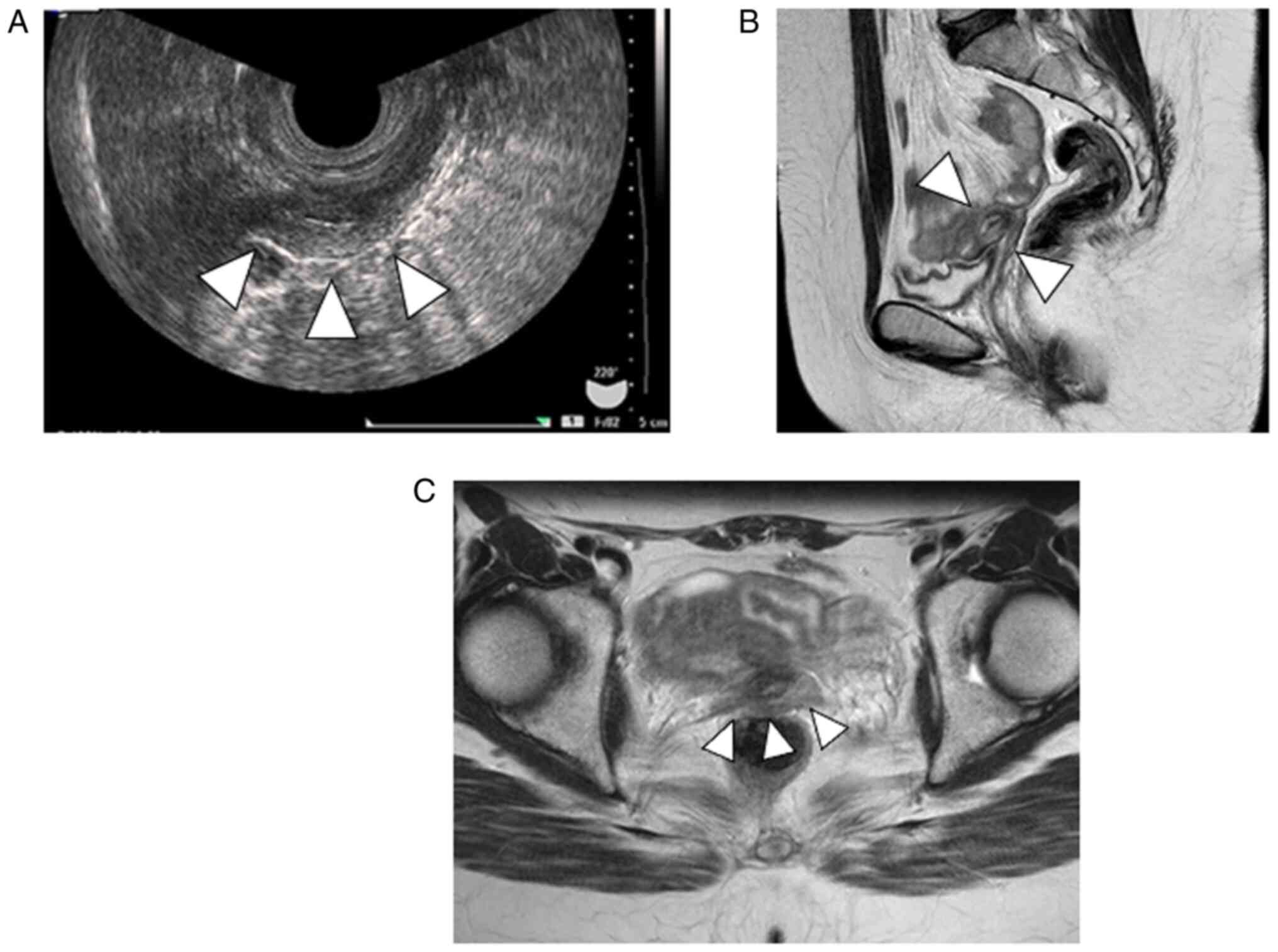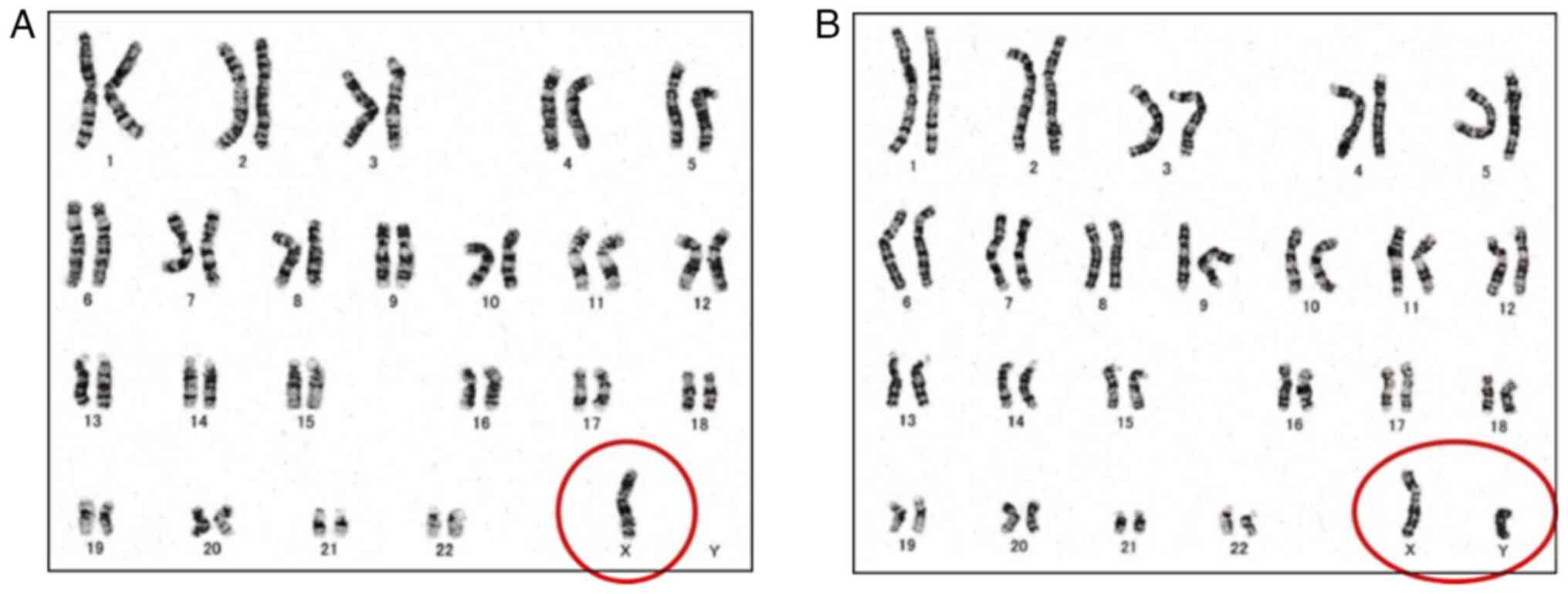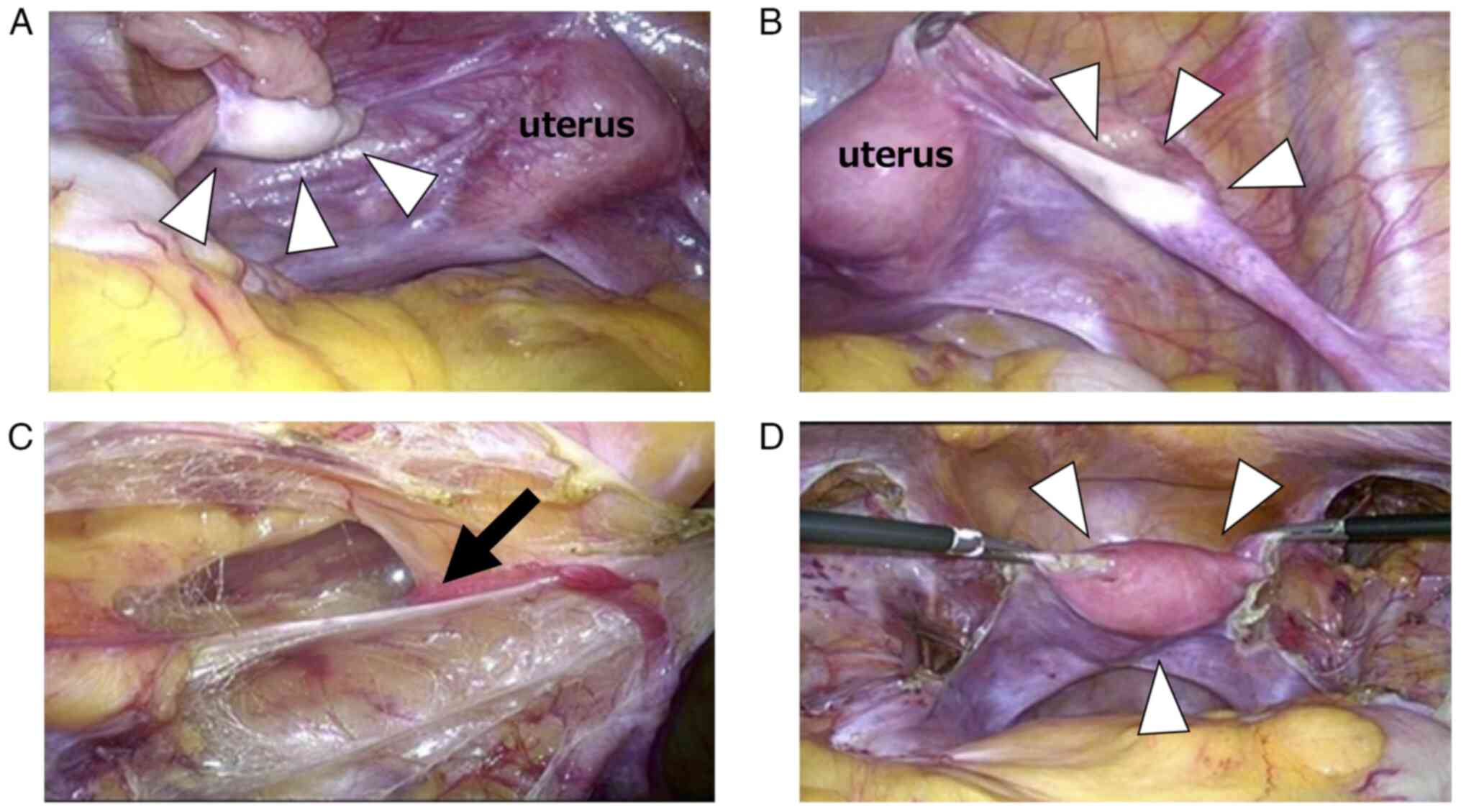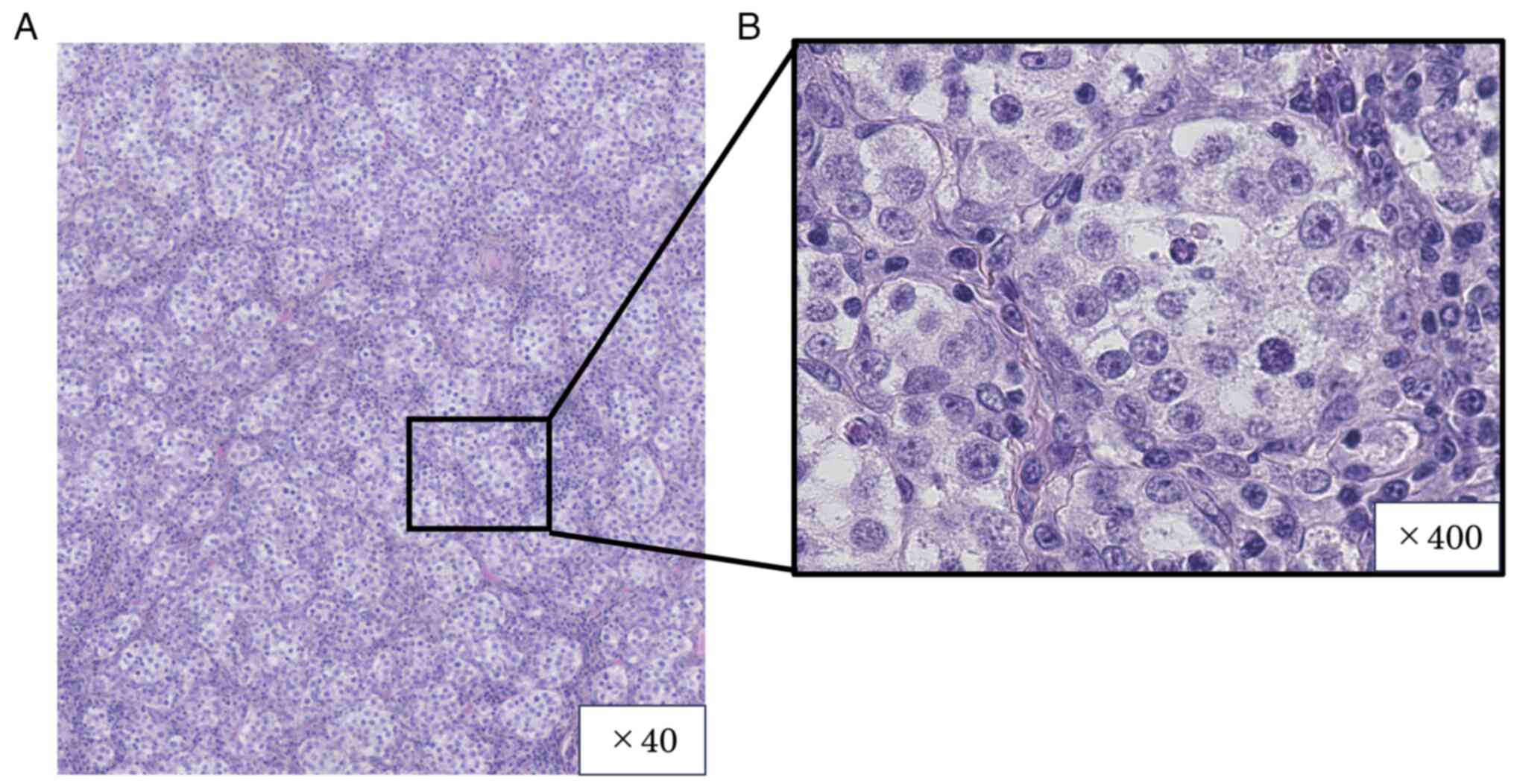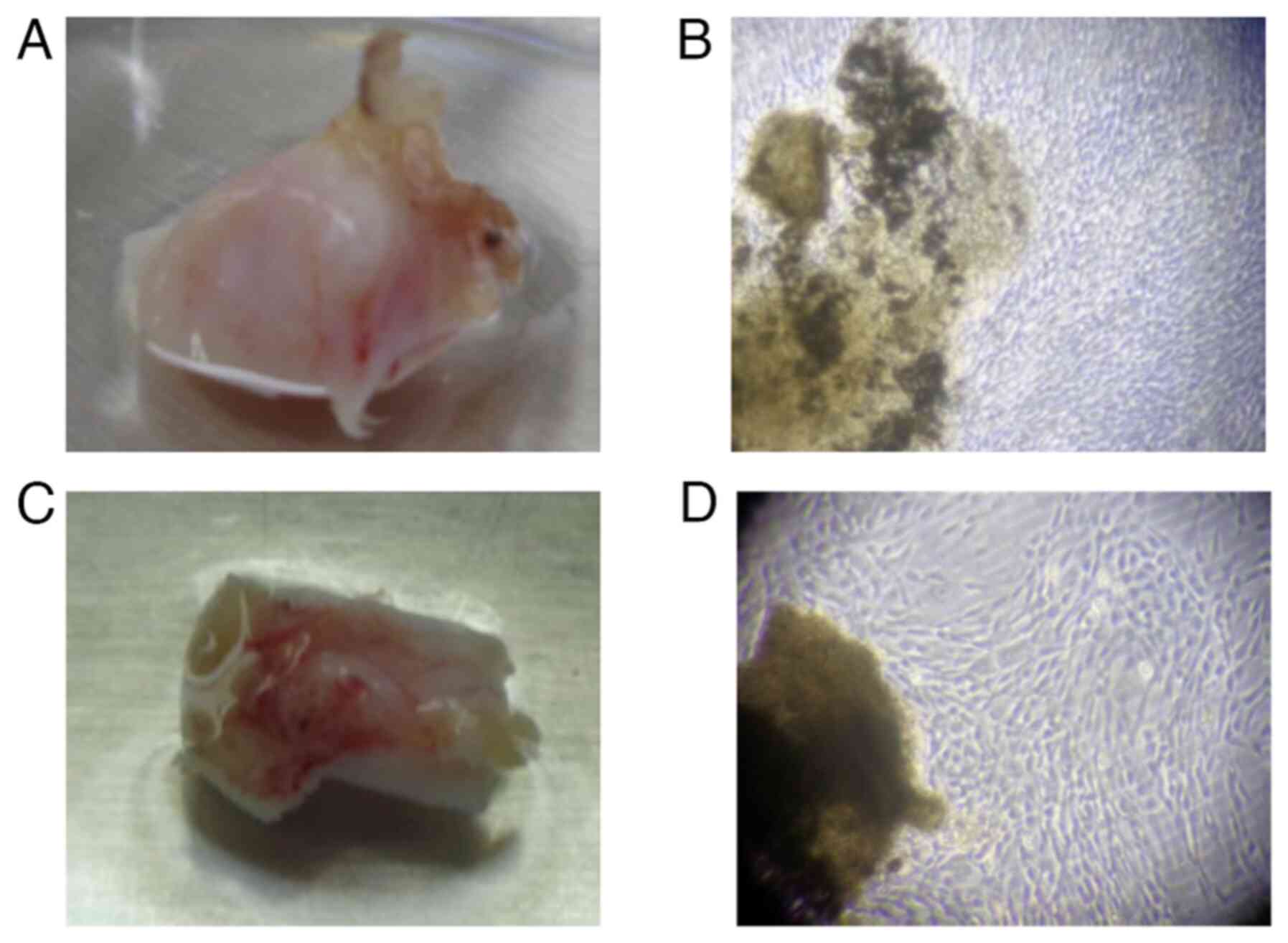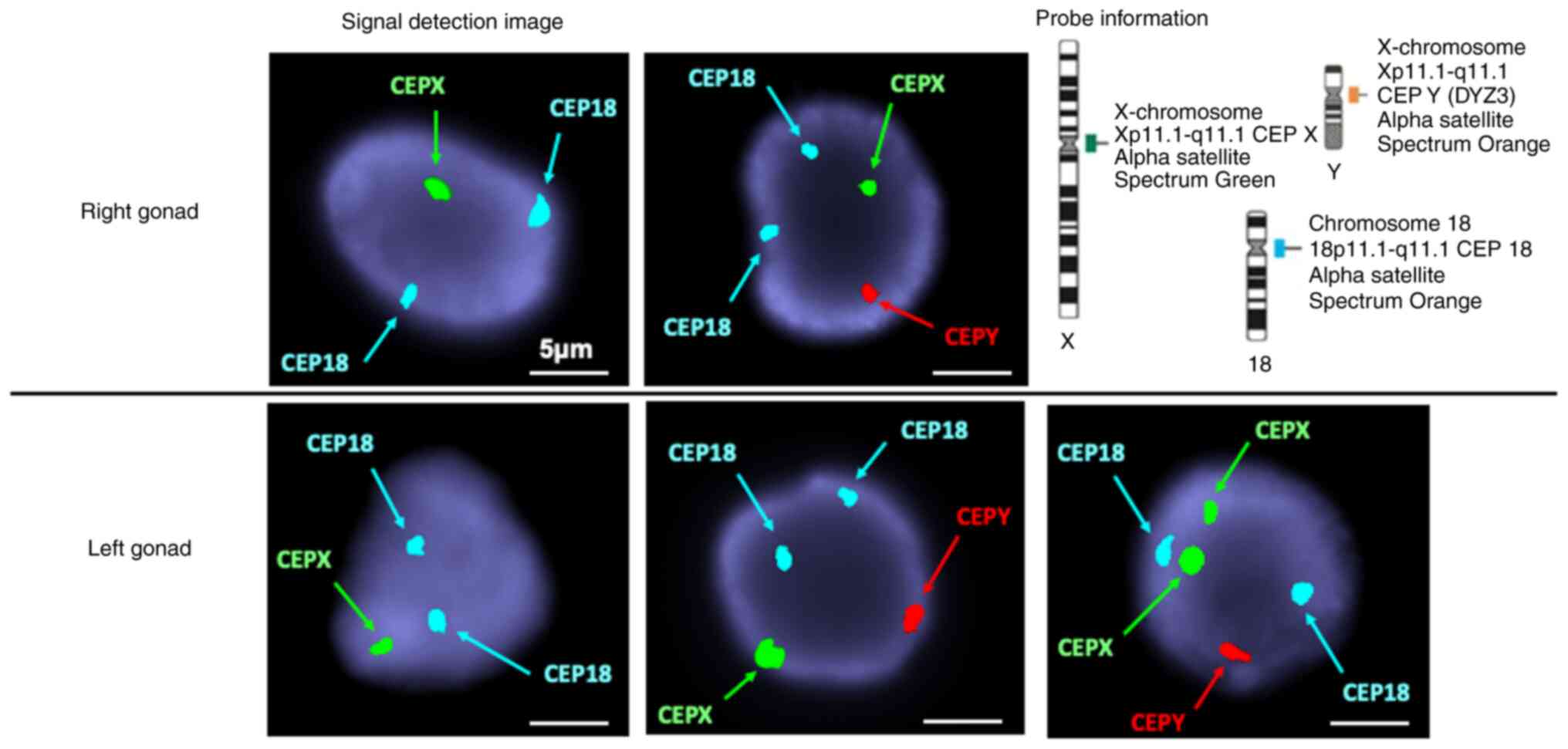Mixed gonadal dysgenesis with gonadoblastoma diagnosed by prophylactic laparoscopic gonadectomy: A case report
- Authors:
- Published online on: July 9, 2024 https://doi.org/10.3892/etm.2024.12647
- Article Number: 358
-
Copyright: © Uyama et al. This is an open access article distributed under the terms of Creative Commons Attribution License.
Abstract
Introduction
Mixed gonadal dysgenesis (MGD) is a disorder of sex development (DSD) characterized by mixed histological findings of cord-like gonads, dysplastic testes, and asymmetrical internal and external genitalia (1). This condition has gained recognition as a common chromosomal abnormality that occurs in 1/6,000 cases (2). The 45,X/46,XY mosaicism is a disorder of sex development that has an estimated incidence of <1/15,000 live births. Each cell originates from a single fertilized egg and, thereby, has the same genetic origin. However, the precise role of gonadal differentiation in MGD remains elusive. Diverse proportions of 45,X and 46,XY cells in the gonads can give rise to various phenotypes-including bilateral testicles, unilateral testicles plus other streak gonads, ovotestes, and bilateral streak gonads. This proportion changes the total amount of testosterone secreted by the bilateral gonads and determines the degree of masculinization of the external genitalia (3,4). The frequency of gonadal tumor complications in patients with MGD is 15-20%. Although the risk of developing gonadoblastoma in individuals with 45,X/46,XY mosaicism is approximately 15-30%, it varies with age (ranging between approximately 3 and 4% at the age of 10 years, to approximately 46% by age 40) (5). Gonadotropins, particularly FSH, have tumor-promoting effects. Their levels are elevated during puberty, resulting in an increased incidence of tumors. Early prophylactic gonadectomy is recommended, given the elevated risk of gonadoblastoma (an anaplastic germ cell tumor [i.e., dysgerminoma]) or other high-grade tumors (3,5,6). However, in diseases with 45,X/46,XY mosaicism, patients often have problems with romantic relationships, owing to a lack of fertility in their oocytes, in addition to abnormal secondary sexual characteristics-as was also the case with our patient. We report a case of MGD diagnosed as primary amenorrhea in a patient who desired to have a child, wherein a gonadoblastoma was found after prophylactic laparoscopic gonadectomy.
Case report
A 21-year-old patient with a female phenotype presented to the hospital with primary amenorrhea, and expressed her desire to have a child. The patient was unmarried and nulligravida. Her height and weight were 146 cm and 67 kg (body mass index, 31.3 kg/m2), respectively. Aside from undergoing tympanoplasty for otitis media at the ages of 7, 9, 10, and 11 years, the patient's medical history was unremarkable. The patient's grandfather had lung cancer, and an uncle had esophageal cancer. There was no family history of gynecological problems, short stature, or consanguineous marriages.
The patient's was quite short in stature; transabdominal ultrasonography revealed hypoplasia of the uterus, which led to a suspicion of Turner's syndrome. The patient had cubitus valgus and a webbed neck, wherein the external genitalia were female. Transrectal ultrasonography (SONOVISTA GX30, Konica Minolta, 1 Sakura-machi, Hino-shi Tokyo 191-8511, Japan) revealed a 30 mm uterus and indistinct bilateral adnexa (Fig. 1A). Contrast-enhanced computed tomography revealed no abnormalities in the cardiovascular system or kidneys. Pelvic contrast-enhanced magnetic resonance imaging (MRI) revealed a 30 mm-long uterus, vaginal thinning, and no structures in the pelvis or inguinal region that could be considered gonads (Fig. 1B and C). Serum hormone tests revealed the following levels: estradiol, ≤5.0 pg/ml (normal range: 13-70 pg/ml); luteinizing hormone, 25.5 mIU/ml (normal range: 1.8-7.0 mIU/ml); and follicle-stimulating hormone (FSH), 98.4 mIU/ml (normal range: 5.2-14.4 mIU/ml). Chromosomal testing via the G-band method was performed of the patient's peripheral blood. The resultant karyotype was 45,X [8]/46,XY [22] (45,X: 8 cells, 46,XY: 22 cells; Fig. 2). Chromosomal testing via the G-band method was performed by SRL, Inc. Therefore, the patient was diagnosed with 45,X/46,XY MGD. Kaufmann therapy was initiated to induce menstruation and maintain her bone mass. Since the patient wished to have a child, adequate counseling was provided by our hospital's Department of Reproductive Medicine and Genetic Medicine. The patient and her family, including her partner, were informed of the difficulty in conceiving using autologous oocytes, possibility of gonadal tumorigenesis, and her elevated risk of developing a malignancy. After thorough counseling for one year, consent was obtained for prophylactic gonadectomy. Imaging revealed no neoplastic lesions, and laparoscopic surgery was performed. Surgical findings revealed a hypoplastic uterus with a white structure and calcifications on the left side (1.5 cm), as well as a cord-like structure on the right side (1.5 cm) that was thought to be a gonad. The broad mesentery was incised along the round ligament of the uterus toward the internal inguinal canal, then expanded to the intersection of the round ligament of the uterus and the inferior abdominal wall artery. Bilateral gonadectomy was performed after confirming the absence of an obvious mass (Fig. 3A-D). Ascites cytology results were negative. Histopathological examination of the left gonadal tissue revealed immature tumor cells growing in numerous small foci. The tumor cells exhibited pale sporangia, nuclear atypia, and nuclear mitosis. Additionally, a small number of large, weakly acidophilic, spore-associated tumor cells growing within the tumor tissue were considered to be Sertoli cells (Fig. 4A and B). All images of the hematoxylin- and eosin-stained sections were obtained with an all-in-one fluorescence microscope (BZ-X710, KEYENCE, Osaka, Japan). Normal ovarian and fallopian tube tissues were observed in the right gonad. The patient was diagnosed with stage IA (FIGO 2014) pT1aN0M0 gonadoblastoma. No additional postoperative systemic chemotherapy was administered. The patient remained recurrence-free and continuously received Kaufmann therapy, which included Estrana Tapes (0.72 mg) (408 Tashirodaikan-machi, Tashiro, Tosu, Saga 841-0017, Japan) every 2 days and Provera (5 mg) (Pfizer, 66 Hudson Boulevard East, New York, NY 10001-2192 USA) for 10 days during the second half of the planned menstrual cycle, to induce proper development of her uterus, as well as prevent cardiovascular disorders and loss of bone density.
To evaluate the patient for gonadal mosaicism, cells derived from the excised left and right gonads were cultured for 12 days (Fig. 5A-D). Chromosomal testing (via the G-band method) was performed using 60 cells from this primary culture. The resultant karyotypes were 45,X [23]/46,XY [37] in the cells derived from the left gonad; and 45, X [38]/46,XY [22] in the cells derived from the right gonad (Table I). Fluorescence in situ hybridization (FISH) was performed by OVUS Inc. FISH was performed according to the manufacturer's protocol (Abbott Molecular Inc., 1300 East Touhy Avenue Des Plaines, IL, USA) on uncultured tissue fixed with Carnoy solution using the AneuVysion Multicolor DNA Probe Kit (Vysis CEP 18/X/Y-alpha satellite/LSI 13/21). FISH was performed on 100 uncultured cells derived from the left and right gonads, using CEP-Y (Spectrum Orange), CEP-X (Spectrum Green), and CEP-18 (Spectrum Aqua) probes. These probes hybridized to the centromeric region of the Y chromosome (Yp11.1-q11.1), X chromosome (Xp11.1-q11.1), and chromosome 18 (18p11.1-q11.1), respectively (Fig. 6). The karyotypes were 45,X [46]/46,XY [52]/47,XXY [2] in the cells derived from the left gonad and 45,X [53]/46,XY [47] in the cells derived from the right gonad (Table I).
Discussion
MGD is one of the most prevalent chromosomal abnormalities, characterized by 45,X/46,XY mosaicism. Initially reported by Sohval in 1963(1). In the present case, the patient was not diagnosed with MGD until her 20s, owing to experiencing primary amenorrhea. Primary amenorrhea is caused by chromosomal abnormalities such as Turner's syndrome. Other causes include hypothalamic, pituitary, or abnormal genital tract differentiation. Chromosomal testing, using peripheral blood lymphocytes, is often used for diagnosis. However, cultured cells derived from the gonads more accurately reflect gonadal mosaic than do peripheral blood lymphocytes. Therefore, performing chromosome and FISH analyses using excised gonads is helpful. FISH analysis can be used for detecting minute deletions and translocations visually and reliably. Many cases have been reported in the literature wherein a patient's peripheral blood lymphocyte chromosomal composition proportion did not match their gonadal or internal/external genital phenotypes. This is because the mosaic ratio at the gonadal developmental stage determines the phenotype of the gonads and subsequent internal and external genitalia. However, the mosaic ratio may change over time, and chromosomal testing results do not always reflect the clinical phenotype (7). In the present case, the percentage of 45,X cells was inconsistent with the results of peripheral blood chromosomal testing (27%), whereas the percentages in the left and right gonads were 38 and 63%, respectively. This difference may have affected the total amount of testosterone secreted, suggesting that the external genitalia were female. Furthermore, FISH analysis of gonad-derived uncultured cells revealed a slight XXY karyotype in the left gonad. Similarly to the case in Turner's syndrome, the 45,X/46,XY mosaic may manifest short stature, webbing of the neck, and external elbow caused by the 45,X cells. Complications such as cardiac and vascular abnormalities, abnormal kidney morphology, otitis media, hearing loss, obesity, diabetes, hypothyroidism, and osteoporosis, may also occur (8,9). Recurrent otitis media, short stature, webbing of the neck and external elbow were observed in this case. However, MGD had not been diagnosed at infancy because the patient's external genitalia were female.
Patients with MGD are at high risk of developing gonadal tumors, including gonadoblastoma (10). Gonadoblastoma is a tumor restricted to the cordate gonads, with a Y chromosome kinetochore region component (11). Gonadotropins, particularly FSH, have tumor-promoting effects. Their levels are elevated during puberty, resulting in an increased incidence of tumors. Although gonadoblastomas are borderline tumors, they may develop into highly malignant gonadal tumors such as dysgerminomas, embryonal carcinomas, and mixed germ cell tumors (5,10). Gonadoblastomas are present in 50% of patients with dysgerminoma (10). Prophylactic gonadectomy for Y chromosome-related sexually differentiated diseases should be performed before puberty (5). The prognosis of gonadoblastoma is favorable if the bilateral gonads, including tumors, are excised-irrespective of the presence of bilateral tumors. In the majority of cases involving pure gonadoblastomas, no post-treatment is indicated. The present case involved a 21-year-old woman with MGD who was at a high risk for tumorigenesis. Gonadoblastoma is classified as a borderline malignancy that should be carefully monitored.
Laparoscopic surgery is the preferred procedure for prophylactic gonadectomy (12). The gonads should be localized preoperatively if possible. However, this is not always easy, because immature gonads may be ectopically present. MRI is the most effective method for assessing the abdominal cavity. However, if the location of the gonads cannot be identified preoperatively, the course of the gonadal arteriovenous vein can be used to identify the gonads. Gonads may also be present in the inguinal canal in sexually differentiated diseases. In such cases, ultrasonography may be used to locate the gonads. However, if the gonads and tumors are not identified preoperatively, adequate intraoperative observation may be necessary. In the present case, a preoperative pelvic MRI did not reveal any structures in the pelvis or inguinal region that could be considered gonads. The presence of a mass in the inguinal canal was confirmed via laparoscopic surgery; masses that could be considered gonads were removed from both sides of the uterus, based on the course of the gonadal arteriovenous vein.
Notification and genetic counseling in cases of chromosomal abnormalities is a comprehensive process that includes: (i) diagnosis and notification; (ii) advice regarding treatment, health care, recuperation, and welfare; and (iii) family planning counseling. During these processes, consideration of the psychological burden on patients and their families is necessary (12). Gonadectomy is recommended due to the risk of developing gonadal tumors. However, understanding and accepting this disease can be difficult. Building relationships with patients and their families through repeated counseling sessions is essential. For appropriate treatment and management, implementing a team-based approach with collaboration between multiple professionals is important, such as genetic and reproductive medicine departments, in addition to the patients and their families.
The 45X/46XY karyotype is characterized by one X chromosome. As a result, any primordial follicles that form are quickly depleted. In such cases, markedly elevated FSH levels indicate a near absence of primordial follicles in the gonads, rendering achieving pregnancy with autologous oocytes extremely challenging. Nonetheless, there have been reports in the literature from outside Japan describing the preservation of primordial follicles following gonad removal. Although no reports have yet confirmed successful pregnancies resulting from this preservation method, future reports on the subject are warranted (13). Alternatively, pregnancy can be achieved through egg donation (this is not currently feasible in Japan) or in vitro fertilization. Some cases wherein pregnancy was achieved with uterine preservation have also been reported (14).
This case report has some limitations. First, it describes only one case, while this disease is known to present in diverse forms. Additionally, whether uterine preservation is recommended and whether it is necessarily advisable to perfom a gonadectomy as soon as possible remain unknown due to the short tracking period. Nevertheless, 45X,46XY MGD is a rare disease and this report aims to draw attention to this rare condition.
In conclusion, we report a case of MGD diagnosed after primary amenorrhea and prophylactic gonadectomy, in which a gonadoblastoma was detected. Early diagnosis of MGD is important, as the risk of developing a highly malignant tumor in the gonads increases after puberty. In cases of primary amenorrhea, this disease should be considered in the differential diagnosis, for which prophylactic gonadectomy is recommended as early as possible after diagnosis. Management should also involve sufficient counseling by a multidisciplinary team to help relieve the psychological burden of the disease.
Acknowledgements
The authors would like to thank Dr Yuki Naru (OVUS Inc. Nagoya, Aichi, Japan) for his cooperation with the chromosome testing.
Funding
Funding: No funding was received.
Availability of data and materials
The data generated in this study are included in the figures and/or tables of this article.
Authors' contributions
TU was a major contributor in writing the manuscript under the guidance of IK. TU and IK confirm the authenticity of all the raw data. TU, IK, KN and HK contributed to analysis and interpretation of the data, and assisted in the preparation of the manuscript. TU, IK, TK, AM, RO, AN, YE, YS, KN, HM, YO, YT, SN, KT, MS, TY, YM, KB and YK have contributed to data collection and interpretation, and critically reviewed the manuscript.
All authors read and approved the final version of the manuscript, and agree to be accountable for all aspects of the work in ensuring that questions related to the accuracy or integrity of any part of the work are appropriately investigated and resolved.
Ethics approval and consent to participate
Our hospital's guidelines exempt case reports from the need for ethics review.
Patient consent for publication
Written informed consent was obtained from the patient to publish this case report.
Competing interests
The authors declare that they have no competing interests.
References
|
Sohval AR: Hermaphroditism with ‘atypical’ or ‘mixed’ gonadal dysgenesis. Relationship To Gonadal Neoplasm. Am J Med. 36:281–292. 1964.PubMed/NCBI View Article : Google Scholar | |
|
Chang HJ, Clark RD and Bachman H: The phenotype of 45,X/46,XY mosaicism: An analysis of 92 prenatally diagnosed cases. Am J Hum Genet. 46:156–167. 1990.PubMed/NCBI | |
|
Huang YC, Lee CT, Wu MZ, Liu SY, Tung YC, Ho HN and Tsai WY: The spectrum of 45,X/46,XY mosaicism in Taiwanese children: The experience of a single center. J Formos Med Assoc. 118 (1 Pt 3):450–456. 2019.PubMed/NCBI View Article : Google Scholar | |
|
Rosa RF, D'Ecclesiis WF, Dibbi RP, Rosa RC, Trevisan P, Graziadio C, Paskulin GA and Zen PR: 45,X/46,XY mosaicism: Report on 14 patients from a Brazilian hospital. A retrospective study. Sao Paulo Med J. 132:332–338. 2014.PubMed/NCBI View Article : Google Scholar | |
|
Kriplani A, Agarwal N, Parul Sharma MC and Manchanda R: Bilateral seminomas in a 45X/46XY mosaic with Turner's phenotype: An unusual case of mixed gonadal dysgenesis. J Obstet Gynaecol Res. 29:63–66. 2003.PubMed/NCBI View Article : Google Scholar | |
|
Lee PA, Houk CP, Ahmed SF and Hughes IA: International Consensus Conference on Intersex organized by the Lawson Wilkins Pediatric Endocrine Society and the European Society for Paediatric Endocrinology. Consensus statement on management of intersex disorders. International consensus conference on intersex. Pediatrics. 118:e488–e500. 2006.PubMed/NCBI View Article : Google Scholar | |
|
Takahashi I, Miyamoto J and Hasegawa Y: Limitations of G-banding karyotype analysis with peripheral lymphocytes in diagnosing mixed gonadal dysgenesis. Clin Pediatr Endocrinol. 15:109–115. 2006.PubMed/NCBI View Article : Google Scholar | |
|
Farrugia MK, Sebire NJ, Achermann JC, Eisawi A, Duffy PG and Mushtaq I: Clinical and gonadal features and early surgical management of 45,X/46,XY and 45,X/47,XYY chromosomal mosaicism presenting with genital anomalies. J Pediatr Urol. 9:139–144. 2013.PubMed/NCBI View Article : Google Scholar | |
|
Berberoğlu M and Şıklar Z: Ankara University Dsd Ethic Committee. The evaluation of cases with Y-chromosome gonadal dysgenesis: Clinical experience over 18 years. J Clin Res Pediatr Endocrinol. 10:30–37. 2018.PubMed/NCBI View Article : Google Scholar | |
|
Verp MS and Simpson JL: Abnormal sexual differentiation and neoplasia. Cancer Genet Cytogenet. 25:191–218. 1987.PubMed/NCBI View Article : Google Scholar | |
|
Page DC: Hypothesis: A Y-chromosomal gene causes gonadoblastoma in dysgenetic gonads. Development. 101 Suppl:S151–S155. 1987.PubMed/NCBI View Article : Google Scholar | |
|
Weidler EM, Pearson M, van Leeuwen K and Garvey E: Clinical management in mixed gonadal dysgenesis with chromosomal mosaicism: Considerations in newborns and adolescents. Semin Pediatr Surg. 28(150841)2019.PubMed/NCBI View Article : Google Scholar | |
|
Siebert AL, Gomez-Lobo V, Johnson EK, Nahata L, Orwig KE, Pyle LC, Witchel SF, Finlayson C and Laronda MM: Differences in gonadal tissue cryopreservation practices for differences of sex development across regions in the United States. Front Endocrinol (Lausanne). 13(990359)2023.PubMed/NCBI View Article : Google Scholar | |
|
Urban A, Knap-Wielgus W, Grymowicz M and Smolarczyk R: Two successful pregnancies after in vitro fertilisation with oocyte donation in a patient with Swyer syndrome-a case report. Prz Menopauzalny. 20:158–161. 2021.PubMed/NCBI View Article : Google Scholar |



